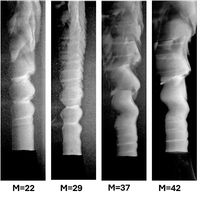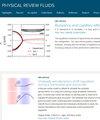Self-sustained oscillations in a low-viscosity round jet
IF 2.5
3区 物理与天体物理
Q2 PHYSICS, FLUIDS & PLASMAS
引用次数: 0
Abstract
The effect of viscosity contrast between a jet and its surroundings is experimentally investigated using density-matched fluids. A gravity-driven flow is established with a jet of saltwater emerging into an ambient medium composed of high-viscosity propylene glycol. Jet Reynolds numbers, , ranging from 1600 to 3400 were studied for an ambient-to-jet viscosity ratio, , between 1 and 50. Visualization suggests that at low values of the viscosity ratio, the jet breakdown mode is axisymmetric, while helical modes develop at high values of viscosity ratio. The transition between these two modes is attempted to be delineated using a variety of diagnostic tools. Hot-film anemometry measurements indicate that the onset of the helical mode is accompanied by the appearance of a discrete peak in the frequency spectrum of velocity fluctuations, which exhibits little spatial variation for the first several diameters in the downstream direction. Laser-induced fluorescence (LIF) is used to identify the jet boundary against the background. An analysis of high-speed images acquired using the LIF technique enables identification of the spatial growth rate of waves on the jet boundary, as well as the frequency of oscillation of the weakly diffusive interface. Temporal fluctuations of fluorescence intensity are found to be spatially invariant in the jet near field, further attesting to behavior consistent with that of a self-sustained oscillation whose frequency depends on the viscosity ratio. The observed frequencies show trends similar to those of absolutely unstable modes calculated from spatiotemporal linear stability theory presented in a companion paper. Spectral proper orthogonal decomposition was used to analyze the images and identify the various spatial modes, and suggests the existence of a single dominant mode. Together, these observations provide strong circumstantial evidence for the existence of a global mode that arises from the absolute instability of velocity and viscosity profiles in a region close to the nozzle exit plane.

低粘度圆形射流中的自持振荡
我们使用密度匹配流体对射流及其周围环境之间的粘度对比效应进行了实验研究。在重力驱动下,盐水射流进入由高粘度丙二醇组成的环境介质。研究了环境与射流的粘度比 M 在 1 到 50 之间时,射流的雷诺数 Re 在 1600 到 3400 之间。可视化结果表明,在粘度比值较低时,射流击穿模式为轴对称模式,而在粘度比值较高时,则会出现螺旋模式。我们尝试使用各种诊断工具来划分这两种模式之间的过渡。热膜风速测量法的测量结果表明,螺旋模式的出现伴随着速度波动频谱中出现一个离散的峰值,该峰值在下游方向的前几个直径处几乎没有空间变化。激光诱导荧光(LIF)用于识别背景中的射流边界。通过分析利用激光诱导荧光技术获取的高速图像,可以确定射流边界上波的空间增长率以及弱扩散界面的振荡频率。研究发现,荧光强度的时间波动在射流近场是空间不变的,这进一步证明了其行为与频率取决于粘度比的自持振荡一致。观测到的频率显示出与根据时空线性稳定性理论计算出的绝对不稳定模式相似的趋势,该理论已在另一篇论文中介绍。光谱正交分解用于分析图像和识别各种空间模式,结果表明存在单一主导模式。总之,这些观测结果为全局模式的存在提供了有力的旁证,这种模式是由靠近喷嘴出口平面区域的速度和粘度剖面的绝对不稳定性引起的。
本文章由计算机程序翻译,如有差异,请以英文原文为准。
求助全文
约1分钟内获得全文
求助全文
来源期刊

Physical Review Fluids
Chemical Engineering-Fluid Flow and Transfer Processes
CiteScore
5.10
自引率
11.10%
发文量
488
期刊介绍:
Physical Review Fluids is APS’s newest online-only journal dedicated to publishing innovative research that will significantly advance the fundamental understanding of fluid dynamics. Physical Review Fluids expands the scope of the APS journals to include additional areas of fluid dynamics research, complements the existing Physical Review collection, and maintains the same quality and reputation that authors and subscribers expect from APS. The journal is published with the endorsement of the APS Division of Fluid Dynamics.
 求助内容:
求助内容: 应助结果提醒方式:
应助结果提醒方式:


